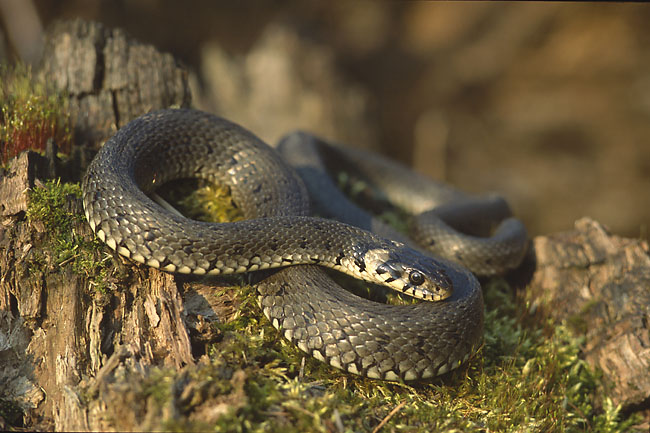Britain's Largest Snake- Grass Snake
Latin name: Natrix natrix
Found across Eurasia, the grass snake holds the status of being classified as Britain's largest snake species. Also known as the ringed snake or as the water snake, the grass snake is often a dull green colour with a yellow ring and black scale patches to be found upon its neck.
Non-venomous, the grass snake has a preference for wetland habitats but is also partial to areas of grassland and gardens with a water source nearby. They are strong swimmers and have been known to stay submerged for over half an hour at a time. Distributed across almost all of England and Wales, surprising this green serpent is almost entirely absent from Scotland and from Northern Ireland.
The diet of the grass snake is made up almost exclusively of amphibians, including toads, frogs and newts. Fish are occasionally consumed along with small mammals and young birds. Once caught, prey is grabbed before being swallowed alive and subsequently digested. However, they are not top of the food chain by any means, as they are predated by badgers, foxes, hedgehogs as well as by certain birds of prey and even domestic housecats.
During the winter months when temperatures are low, grass snakes find frost-free areas to settle down and hibernate. When they emerge around about April time, courting of mates occurs almost straight away. Grass snakes are Britain's only egg-laying snake and they tend to be laid in areas of rotting vegetation such as compost or manure heaps. Approximately, 8-40 eggs are laid and hatch after about 10 weeks. Grass snakes can live for up to 15 years.
Although classified as a species of least concern in terms of conservation status, the species' preferential habitat is under threat with the loss of grassland and wetland in this country having the potential to become a real issue for our nation's reptiles.
 |
| Grass snake courtesy of Marek Szczepanek |
Found across Eurasia, the grass snake holds the status of being classified as Britain's largest snake species. Also known as the ringed snake or as the water snake, the grass snake is often a dull green colour with a yellow ring and black scale patches to be found upon its neck.
Non-venomous, the grass snake has a preference for wetland habitats but is also partial to areas of grassland and gardens with a water source nearby. They are strong swimmers and have been known to stay submerged for over half an hour at a time. Distributed across almost all of England and Wales, surprising this green serpent is almost entirely absent from Scotland and from Northern Ireland.
The diet of the grass snake is made up almost exclusively of amphibians, including toads, frogs and newts. Fish are occasionally consumed along with small mammals and young birds. Once caught, prey is grabbed before being swallowed alive and subsequently digested. However, they are not top of the food chain by any means, as they are predated by badgers, foxes, hedgehogs as well as by certain birds of prey and even domestic housecats.
During the winter months when temperatures are low, grass snakes find frost-free areas to settle down and hibernate. When they emerge around about April time, courting of mates occurs almost straight away. Grass snakes are Britain's only egg-laying snake and they tend to be laid in areas of rotting vegetation such as compost or manure heaps. Approximately, 8-40 eggs are laid and hatch after about 10 weeks. Grass snakes can live for up to 15 years.
Although classified as a species of least concern in terms of conservation status, the species' preferential habitat is under threat with the loss of grassland and wetland in this country having the potential to become a real issue for our nation's reptiles.
Comments
Post a Comment